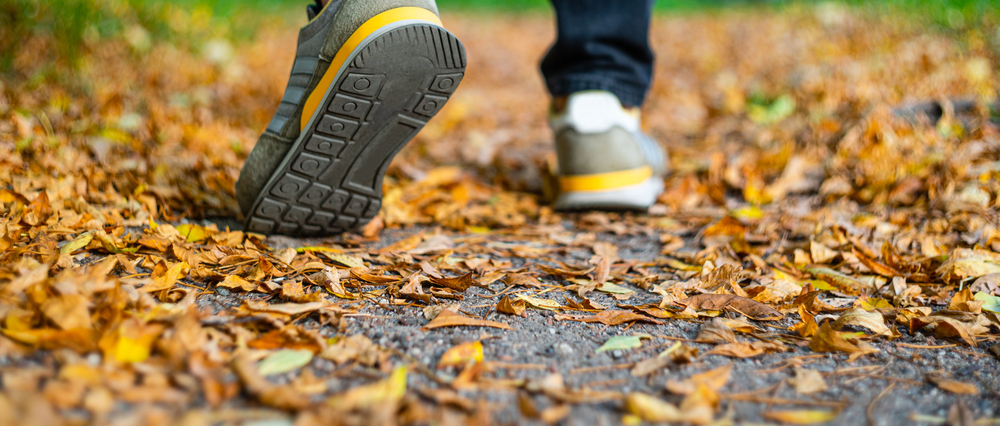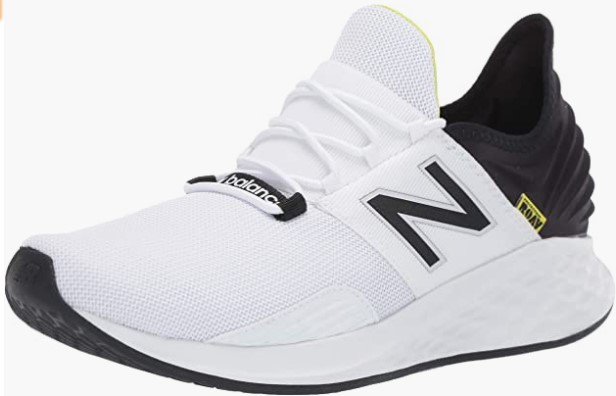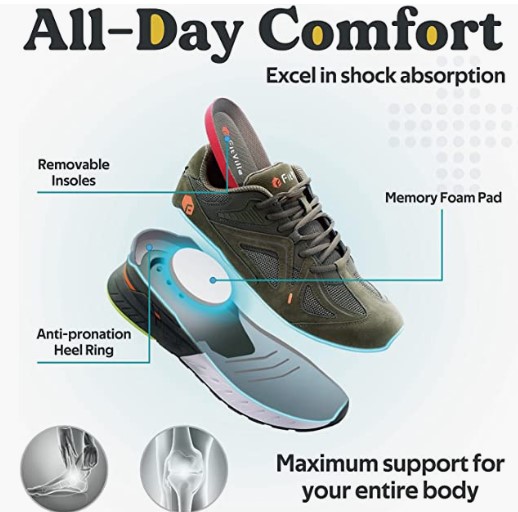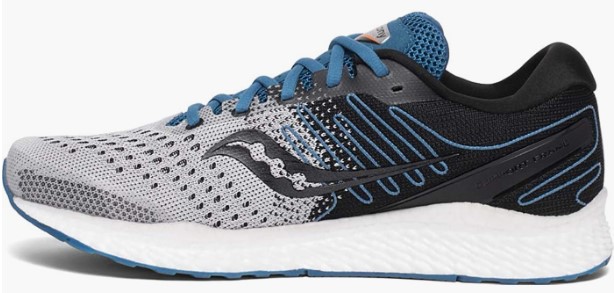Flat feet refers to the condition where the ground surface is level or even slightly elevated. If you have flat feet, then chances are your shoes may not fit properly. Your feet and your shoe size change over time. You may have grown taller than you were when you first started wearing those cute flats!
The issue of flat feet generally occurs due to two causes: either your foot bones start expanding, causing the arch to flatten out, or your arches start collapsing, causing the ball of your foot to sink down. Either way, they cause your foot to lose its normal shape and become bent at the bottom. When this happens, your shoes don't fit right anymore, and you have trouble walking comfortably. You probably know how uncomfortable it feels when your shoes pinch your toes or rub against them; if you've been experiencing these symptoms, you have flat feet.
-
New Balance Men's Fresh Foam Roav V1 Sneaker
![New Balance Men's Fresh Foam Roav V1 Sneaker]()
New Balance is known for their sporty looking shoes, and that includes their walking shoes. The New Balance 811 is an excellent option if you do a lot of walking or hiking. The New Balance Fresh Foam Roav v1 running shoes are the ultimate in casual athletic style. Pairing a bold, attractive look with plush comfort, these cushioned running shoes are in a league of their own. These casual athletic runners are perfect for work or a run around the block.
The Fresh Foam midsole is great for cushioning and lightweight ride, while the Ndurance outsole provides superior durability in high-wear areas to help get more out of your favorite running shoes. Bring your every step to life with the New Balance men's Fresh Foam Roav V1 sneaker.
These athletic shoes feature a mesh upper and breathable mesh lining for everyday comfort, as well as adidas' Aegis support system for stability and protection. With an almost perfect design and lightweight cushioning, these neutral running shoes wrap around your foot like a second skin for an extra cushioned walk. And, to keep your feet happy after long days of wear, the Ultra Heel hugs the back of your foot for an awesome supportive fit.
| Brand Size | UK | Europe | Heel to toe |
|---|
| 5 | 4.5 | 37.5 | 9.1 |
| 5.5 | 5 | 38 | 9.2 |
| 6 | 5.5 | 38.5 | 9.4 |
| 6.5 | 6 | 39.5 | 9.7 |
| 7 | 6.5 | 40 | 9.8 |
| 7.5 | 7 | 40.5 | 10 |
| 8 | 7.5 | 41.5 | 10.2 |
| 8.5 | 8 | 42 | 10.4 |
| 9 | 8.5 | 42.5 | 10.6 |
| 9.5 | 9 | 43 | 10.8 |
| 10 | 9.5 | 44 | 11 |
| 10.5 | 10 | 44.5 | 11.2 |
| 11 | 10.5 | 45 | 11.4 |
| 11.5 | 11 | 45.5 | 11.6 |
| 12 | 11.5 | 46.5 | 11.8 |
| 12.5 | 12 | 47 | 12 |
| 13 | 12.5 | 47.5 | 12.2 |
| 14 | 13.5 | 49 | 12.6 |
| 15 | 14.5 | 50 | 13 |
| 16 | 15.5 | 51 | 13.4 |
-
FitVille Extra Wide Walking Shoes for Men
![FitVille Extra Wide Walking Shoes for Men]()
These are built for comfort walking. Their cushioned rubber sole provides superior shock absorption and stability. They are incredibly durable, especially if you plan on doing lots of walking.
Designed especially for the people who suffer from fatigue and foot pain. FitVille is designed with a higher instep, wide-toe-box design, which will help you get more comfortable when you walk around all day. The non-slip outsole provides your feet with extra grip while walking. The non-skid soles will keep you steady and comfortable as you walk or stand.
Are you tired of walking around all day, with feet pain? Try this extra wide shoe! Designed with high-instep and wide-toe box, it can help you walk comfortably. It will help you stand straight and look stylish as well.
| Brand Size | US Size | Heel to toe |
|---|
| 7 | 7 | 9.7 |
| 7.5 | 7.5 | 9.9 |
| 8 | 8 | 10.1 |
| 8.5 | 8.5 | 10.2 |
| 9 | 9 | 10.4 |
| 9.5 | 9.5 | 10.6 |
| 10 | 10 | 10.8 |
| 10.5 | 10.5 | 10.9 |
-
Saucony Freedom 3
![Saucony Freedom 3]()
The Saucony Freedom 3 is the all-around daily trainer, built to support the needs of today's active lifestyles. It includes a patented PropelCore sole that provides your feet with both great support and unprecedented cushioning thus maximizes comfort and minimizes foot fatigue. The supportive mesh fabric upper provides ultimate breathability, while the non-slip outsoles allow your feet to grip while you move.
Get the freedom your feet deserve. Our Saucony Freedom 3 features a plush cushioning, durable suede and mesh fabric upper that's lightweight and breathable, while the rubber outsole gives you a solid foundation for all day comfort.
| Brand Size | UK | Europe | Canada | Japan |
|---|
| 3 | 2 | 35 | | |
| 3.5 | 2.5 | 35.5 | | |
| 4 | 3 | 36 | | |
| 4.5 | 3.5 | 37 | 22.5 | 225 |
| 5 | 4 | 37.5 | 23 | 230 |
| 5.5 | 4.5 | 38 | 23.5 | 235 |
| 6 | 5 | 38.5 | 24 | 240 |
| 6.5 | 5.5 | 39 | 24.5 | 245 |
| 7 | 6 | 40 | 25 | 250 |
| 7.5 | 6.5 | 40.5 | 25.5 | 255 |
| 8 | 7 | 41 | 26 | 260 |
| 8.5 | 7.5 | 42 | 26.5 | 265 |
| 9 | 8 | 42.5 | 27 | 270 |
| 9.5 | 8.5 | 43 | 27.5 | 275 |
| 10 | 9 | 44 | 28 | 280 |
| 10.5 | 9.5 | 44.5 | 28.5 | 285 |
| 11 | 10 | 45 | 29 | 290 |
| 11.5 | 10.5 | 46 | 29.5 | 295 |
| 12 | 11 | 46.5 | 30 | 300 |
| 12.5 | 11.5 | 47 | 30.5 | 305 |
| 13 | 12 | 48 | 31 | 310 |
| 14 | 13 | 49 | | |
| 15 | 14 | 50 | | |
| 16 | 15 | 51.5 | | |
What Is Overpronation?
Overpronation means excess pronation, and occurs when your feet roll inward excessively at the ankle joint. Pronation is the movement of the foot downward at the end of each step. Your foot naturally rolls inward due to muscle contraction, ligament laxity (tendons become loose), overuse, and/or injury. When your foot rolls inwards excessively, the heel becomes hyper-extended, and it may cause pain, injury, and even deformities.
What Causes Overpronation?
There are three common causes of overpronation: genetics, trauma, and biomechanical abnormalities. A few examples of biomechanical abnormalities include flatfeet, high arches, pes planus, varus, and valgus deformities of the knee. Genetics play a significant role in developing overpronation, and often times, they cannot be prevented.
How Does Overpronation Affect Us?
Overpronation leads to injuries such as Achilles tendinitis, stress fractures, shin splints, metatarsal strains, shin splints, plantar fasciitis, calf cramps and many others. These injuries occur in athletes who participate in sports where there is repetitive jumping and running. Additionally, overpronators experience increased risk of falls due to their inability to control body momentum.
Treatment Options
Treatment options for overpronation include orthotics, surgery, physical therapy, stretching exercises, bracing, shoes, custom orthotics, and gait training. Orthotic devices help stabilize the arch and provide cushioning and shock absorption. Surgery is only recommended if conservative treatment fails. Physical Therapy is effective for strengthening muscles and bones, while stretching helps prevent injuries caused by overpronation. Braces are helpful in managing injuries related to overpronation and preventing them from occurring again. Shoes should be properly fitted, and custom orthotics can reduce pressure from the forefoot and increase stability. Gait training involves altering how the leg moves and walking patterns.
Prevention
Prevention of overpronation includes modifying activities that cause excessive motion at the ankle, wearing proper footwear, correcting any biomechanical abnormalities, and performing regular stretching exercises to strengthen weak supporting muscles.
Symptoms Of Flat Feet
Sore feet
Flat feet occur when there's an overabundance of fluid buildup in between your toes and your shoes. Fluid build-up can cause soreness and discomfort around the bottom of your foot, especially if you're walking barefoot. If you walk around with sores or calluses on your feet, then you may have flat feet.
Aching feet
Aching feet occurs when you don't get enough blood flow to your feet. Your body produces blood when it senses that your muscles need more oxygen than they're getting. When your feet aren't receiving enough oxygen, then they begin to ache.
Painful feet
Painful feet occur when your bones become irritated due to weak connective tissue. As soon as your bones start becoming sore, they'll send out pain signals throughout your entire body.
Tired feet
Tired feet occur when your feet become tired from standing all day long at work. When you stand for prolonged periods of time, your feet take a beating. Overworked feet can lead to painful blisters. Make sure to take breaks and stretch your feet frequently.
Cracked heels
Cracked heels occur when your heel bone becomes cracked. Heel bones are extremely hard in comparison to any other bone in your body. Since your heel bone is exposed to a lot of pressure from weight-bearing activities, it can become brittle and break. This can make the area feel tender and hurt.
What Causes Flat Feet?
There are several factors that contribute to flat feet. These may be hereditary or caused by other factors. Here I'll discuss some of the possible conditions that lead to flat feet.
Genetics
If both parents have flat feet, their children have a 50% chance of developing flat feet. However, if only one parent has flat feet, the child's risk is 25%. On the flip side, if neither parent has flat feet, there is no risk of having flat feet.
Ageing
As you get older, your joints begin to wear out and break apart. As a result, your muscles relax, and your ligaments loosen, allowing your foot bones to expand (or "grow"). This is called osteoarthritis, and it's one of the leading reasons people develop flat feet.
Overweight
Being overweight contributes to a number of illnesses, including diabetes, high blood pressure, heart disease, and arthritis. Overweight individuals tend to have less bone density than thinner people, meaning they're more likely to develop flat feet.
Injury
An injury to your ankle or knee can leave your leg muscles weak and cause your foot bones to shift. This can cause your arch to collapse and make your foot appear flat.
Other Factors
Some medications prescribed for certain medical problems can cause flat feet. Some examples include diuretics (medications that help you urinate) and cortisone injections. Certain forms of arthritis can affect your feet. In addition, certain types of infections, such as gout, can weaken your ankles.
What to look for in a shoe for flat feet?
Whenever you go shopping for a shoe, it is always best to know what to look for. If you choose the wrong type of shoe, you will regret your purchase eventually. Here are some things to look for in a shoe for overpronation and flat feet.
Arch Support
The arch of your foot is responsible for supporting your entire body weight and is composed of muscles, ligaments, tendons, bones and joints. When these structures become weak or injured, they are unable to maintain proper alignment, balance, and support which causes flat feet. There are many ways to strengthen and improve this area including physical therapy, braces, orthotics, surgery, shoe inserts, and custom orthotics.
Durability
In order to effectively function, the arch must have adequate strength and durability. If not properly supported, you may experience pain, discomfort, and inflammation. When looking at durable products, consider material quality, size, fit, and comfort.
Shoe size
First of all determine what your foot type is and make sure that you buy shoes that fit correctly. If you have flat feet then you need shoes that are wider than normal. In general you want the width between the ball of your foot and the heel to be at least 10mm. If possible go for a half size larger than your usual shoe size.
Comfortable
You should always check out any potential shoe before buying them. You don't want to have sore feet after wearing them around for days! Also try on different types of footwear when you get home. Wear them around the house and give yourself time to get used to them. Make sure they feel comfortable and not constricting in their grip.
Breathable
Make sure that your shoes do not cause sweating because if you do this you might end up having fungus in your toes. Check the interior material of the shoe to make sure that it does not cause blisters. Look to see if you are able to move your toes freely. Wearing shoes which don't allow maximum movement can lead to problems later on.
Insoles
The insoles are a great way to increase comfort and decrease pain. If you have existing injuries or conditions then it's best to consult your doctor first before purchasing these products. However, if you suffer from chronic pain or swelling then you may benefit from using them.
Rubber soles
Rubber soled shoes reduce friction and provide traction. They are useful for people who spend lots of time walking either indoors or outdoors. If you have bad knees, ankles, or hips then rubber-soled footwear will help prevent damage.
Strap
A strap helps ensure that the shoe stays securely on your foot. If your shoe straps come loose then this can lead to discomfort and even injury. Your foot tends to swell over time and the strap keeps the shoe firmly in place. To keep your straps secure, avoid putting heavy items inside your shoes. This includes water bottles, clothing, and books.
How To Tell If You're Flat Footed
You may notice small cracks forming between your toes and around your ankle bones. If these cracks get bigger, they may swell up and hurt.
On the inside of your foot, you may find a lumpy area. These lumps are actually the bone spurs that cause your feet to flatten.
You may have difficulty wearing shoes because the pressure caused by wearing tight fitting shoes makes the pain worse. In addition to being painful, having flat feet can make walking difficult.
Treatments And Prevention Tips
- To prevent flat feet, try to keep your muscles strong.
- Get plenty of exercise and wear good quality shoes that fit well.
- Wearing orthotics or custom-made insoles can help support your arches and reduce irritation.
- To treat your flat feet, try stretching exercises and icing after exercising.
- Ice helps relieve the swelling and soreness.
- Also, try taking antihistamines to help ease inflammation.
Why Are Flat Feet Bad
Flat feet may not seem like much at first glance, but if left untreated, they could lead to severe consequences. People who develop flat feet often experience symptoms like discomfort while walking, poor posture, muscle strain, and even headaches. Fortunately, most cases of flat feet can be treated medically, including prescription inserts and orthotics. You should consult a podiatrist if you think you might have flat feet, since they can be cured sooner rather than later with proper treatment.
There are two main types of flat feet; hallux valgus and pes planus. Both of these conditions develop when the arch of the foot collapses or flattens out. In both instances, the toes point inward instead of outward. Commonly associated with flat feet, bunion deformities can occur as well. Bony prominences on the bottom of the big toe or anywhere along its length can become painful if they are allowed to progress. As mentioned before, these types of conditions can be treated effectively with orthotics.
Another way to treat flat feet is to have surgery performed. This type of procedure involves cutting away parts of the bones of the arch to correct the problem. While this is a drastic option, it is generally reserved for severe cases of flat feet. In some cases, doctors will recommend bone grafting in order to stimulate growth of new cartilage inside an affected area. Surgery can also be effective in correcting any deformities that might exist.
An alternative to orthotics and surgery is to wear supportive footwear. This is a great choice for many patients whose foot structure does not warrant the use of special shoes or supports. By wearing a pair of comfortable shoes with good shock absorption features, patients can reduce inflammation and pressure points caused by flat feet. Wearing shoes that are tailored to fit properly can also greatly decrease the amount of movement between the foot and shoe.
One of the best ways to avoid developing flat feet is to watch what you eat. Poor nutrition can contribute to flat feet, so making sure you get plenty of protein and vitamins D and K can go a long way toward preventing the onset of this condition. Taking omega-3 supplements, especially fish oil, is another great way to keep your body running smoothly.
Choose the right size
In general, women who wear a size 8 should get men's sizes 9-11 and vice versa. To find the size you're looking for, we recommend measuring your foot at its widest point - between your longest toe and your heel. You can use a tape measure, ruler, or string with a knot tied off at the end. To find your foot length, wrap the string around the sole of your foot until you reach the back of your heel where you'll find the mark.
Pick a style that fits comfortably!
It might seem obvious, but comfortable shoes don't mean boring shoes. Look for styles that fit well and feel good for your comfort level. Try on a variety of different styles and then pick what feels best. Don't forget to test your sneakers before wearing them home - if they pinch or rub at first, you know they aren't going to work long term.
Subscribe
Stay updated with our newsletter
Main Image provided by: depositphotos.com
Conclusion
We hope you enjoyed our article on the best walking shoes for overpronation and flat feet. Whether you have overpronation or flat feet, you should find a good pair of shoes that will support you. To find the best walking shoes for you, use the tips in this article and your shoe game will be on point! Keep these things in mind when searching for the best walking shoes for you. If you have any questions, please don't hesitate to reach out to us on our Contact Page. Cheers, and happy walking!




